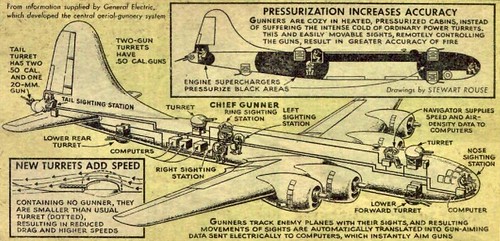The crew’s defensive capability was limited by the skill of its gunners, who fired independently at targets of their own choosing. The most notable examples of these bombers were the B-17 and B-24, which were primarily deployed in Europe, where they were subject to ruthless flak and fighter attacks. Thousands of them were lost.
The B-29 Superfortress, which was only deployed in the Pacific theater, was a revolutionary advance in bomber design. First of all, it was the first aircraft in the world to have completely pressurized crew compartments (the bomb bay was not pressurized), which were also heated. My father described it as a “shirtsleeve environment.”
The range of the B-29 (3,250 miles) far outdistanced its predecessors, the B-17 Flying Fortress (2,000 miles) and the B-24 Liberator (2,100 miles). More significantly, the B-29 could carry a staggering 20,000 pounds of bombs, four times the capacity of the B-24 and 10 times the capacity of the B-17.
In addition, a new gunnery system was developed for the B-29. The Chief Gunner didn’t actually fire a weapon. Instead, he operated a sighting device that used newly-developed on-board “electric computers” to calculate the aiming points for the ship’s guns, which were aimed and fired by remote control. The only exception was the tail gun, which was fired manually by the Tail Gunner. At any point, any other crew members could assume manual control of one of the remote-controlled gunning stations, if necessary.

When my father completed his bombardier training, he was assigned to a crew, and departed from Alamagordo, New Mexico in a brand-new, shiny B-29. However, once they arrived in Guam, they were ferried by boat to Saipan, and assigned one of the oldest B-29s on the base. They expressed some disgust over this “bait-and-switch” tactic, but soon discovered that their ground crew was run by Master Sergeant Chester Moody, a seasoned veteran who took great pride in his work, and ensured that every glitch in the Black Magic was fixed quickly and correctly. Rather than petition the base commander for a newer aircraft, the crew stuck with Black Magic and Sergeant Moody.
My father told me that missions typically lasted around 16 hours. The Japanese were warned ahead of time by aircraft dropping leaflets that certain cities had been targeted for bombing raids, but the leaflets didn’t say exactly which city would be bombed, or when. This was to enable the Japanese to take steps to protect their civilian population.
The Black Magic would fly from the island of Saipan in the Mariana Islands (over a thousand miles south of Japan) to the northernmost of the Japanese islands, complete a bombing raid and have just enough fuel to return to Saipan. Once the island of Iwo Jima was captured, damaged or fuel-starved aircraft could find a friendly airstrip that was about 500 miles closer to Saipan.
According to my father, the most detested duty was nighttime “Pathfinder” flights. A solitary bomber would be sent over the target area with no bomb load, while the rest of the squadron waited in a holding pattern offshore. They would fly a figure-8 pattern directly over the target, at low altitude and in full view of the enemy spotlights. The cabin would be depressurized, and a crew member would drop spools of what they called “rope” – actually rolls of aluminum foil - through the camera bay door. These spools would unwind as they fell, drifting through the enemy radar to produce false echoes. Then the squadron of loaded bombers would fly in and drop their bombs, invisible to the enemy radar. But of course, the Pathfinder aircraft was a sitting duck until the mission ended. Thank goodness Pathfinder missions were handed out in rotation so nobody had to do it more than once or twice.

No comments:
Post a Comment